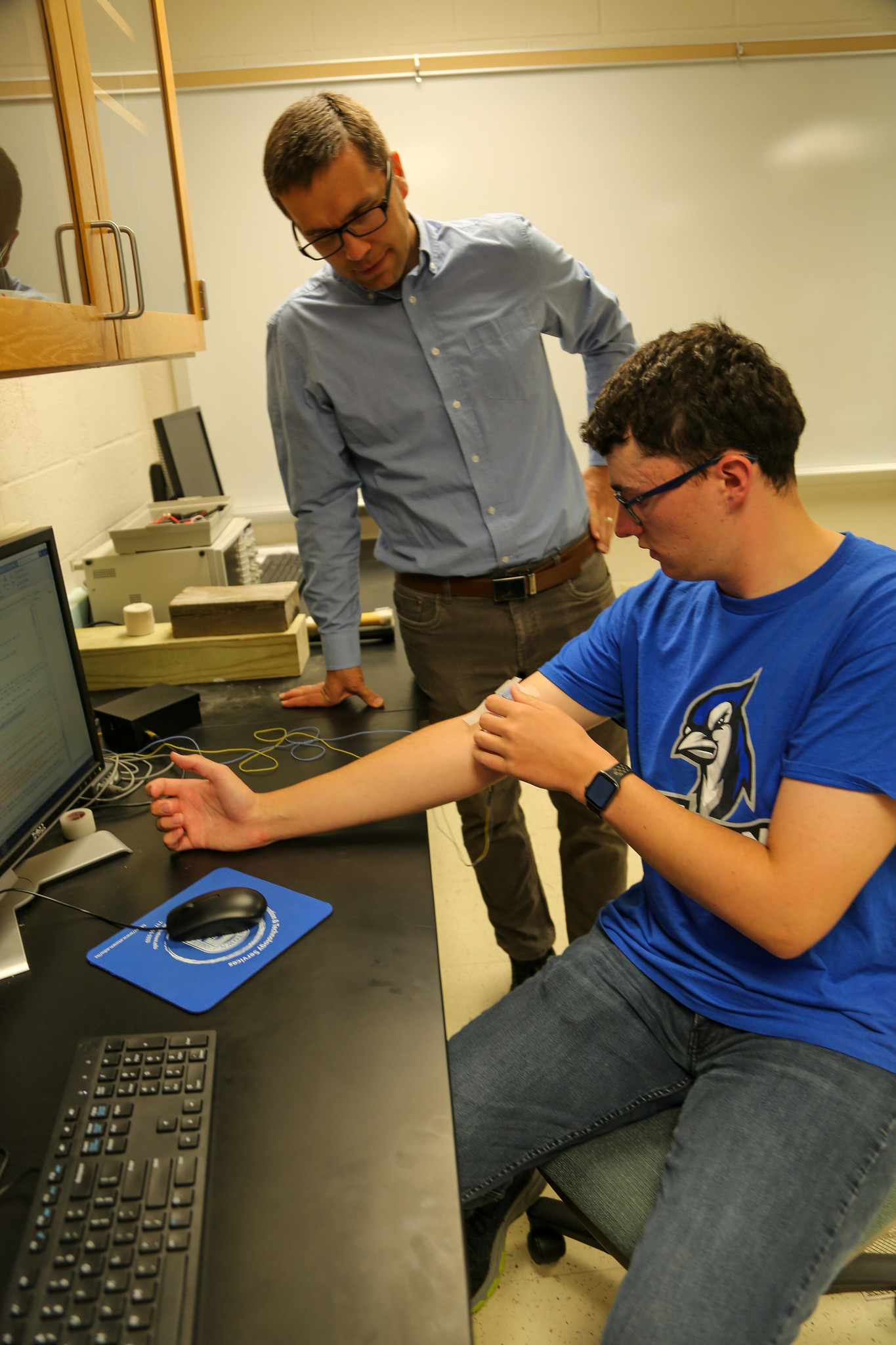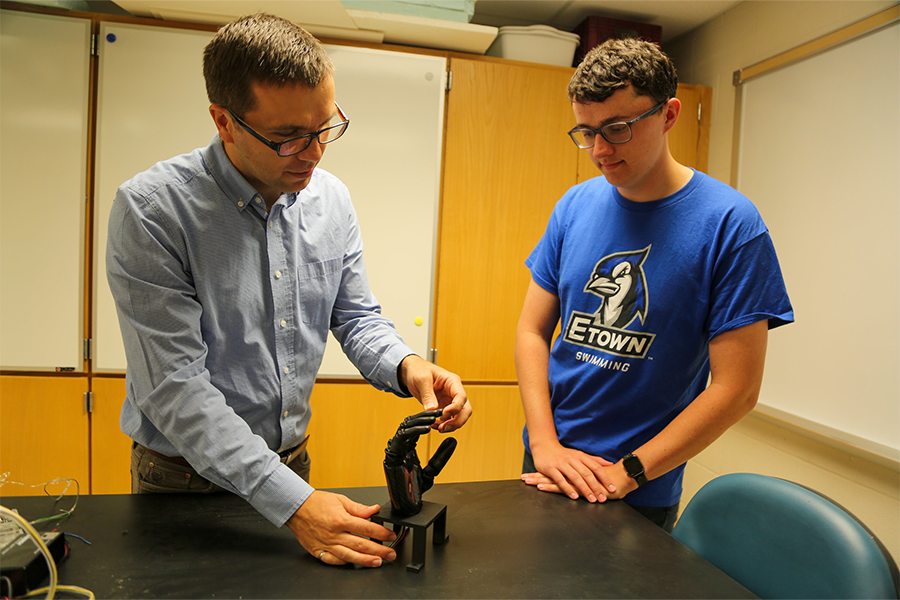Elizabethtown College Engineering major and member of the Blue Jay men’s swimming team Robert Midura ’23 is conducting research on campus this summer to help create a natural feeling for prosthetics by using electric stimulation as part of the Elizabethtown College Summer Creative Arts and Research Program (SCARP).
Midura has been working alongside faculty mentor and Assistant Professor of Engineering & Physics Mark Brinton, researching different variations of electrical stimulation in hopes of finding a cost-effective and minimally invasive solution for prosthetics users to regain natural feeling, as high-end prosthetics can cost upwards of $100,000.
The ultimate goal of Midura’s research is to find the parameters that make artificial stimulation feel the same as human touch.
Title of Research
Effect of Biomimicry on Perceived Intensity in Electrocutaneous Sensory Feedback
Student Researcher
Robert Midura ’23 (Engineering major)
Faculty Mentor
Mark Brinton, PhD, Assistant Professor of Engineering & Physics
What are you researching?
Midura: My research project with Dr. Brinton focuses on developing natural feeling from artificial electronic stimulation. There are millions of nerves/neurons in the body that all have different functions. One type is motor neurons responsible for sending information from the brain to the rest of the body to cause us to move our feet, legs, hands, and arms. The general type of neurons I am focusing on are sensory neurons that help detect the world around us. There are many types of sensory neurons that are responsible for sensing all different types of things like heat, pressure, pain, and much more. The skin has multiple sensory neurons that allow us to detect our surrounding environment. When we touch something, select sensory neurons detect and send tiny electrical signals down other neurons that lead back to the spin and brain. Here the information is decoded to determine what we are detecting and with what intensity. All of this happens within milliseconds, and it feels instant to us. Artificial electrical stimulation can activate these same sensory neurons and send information back to the brain. By using a stimulation pad with electrodes and attaching it to dampened skin, an electrical field can be produced that stimulates sensory neurons and sends feedback to the brain. However, the information these neurons are sending is sensitive, and the brain can tell that the artificial stimulation is not the same as someone poking you on the arm with their finger.
Why did you choose this topic?
Midura: I chose this topic because I not only find the human body interesting, but I also want to put my education and knowledge to use in helping others. As a mechanical engineering student, I see the human body differently than a biologist or doctor. The body is a complex and self-learning machine. Our limbs and other body parts can be seen as parts of a car, our nerves as electrical wires that connect these parts together and to the computer of the car, or the brain in our case, that then interprets information and sends commands. This project connects this idea that the human body, as complex as it may be, is just a designed, wired, and operating machine and is meant to be able to help others, specifically those who use or could use prosthetics. Many people with missing limbs, either born without or amputees, do not always use prosthetics. Even though prosthetics offer some mobility and functionality back to these individuals, many people choose not to use them because they feel a prosthetic is not worth the hassle of trying to use and say that to use their prosthetic, they must watch what it is doing to be able to control it. They need to visually see how their prosthetics are, for example, grabbing something, how tight it is holding something, etc. This research centered on trying to help these individuals. By developing prosthetics with feeling, prosthetic users can distinguish between objects they are touching, determine if they are cold or hot, hard, or soft, stiff, or malleable and control their grip strength, and much more that we take for granted.
What is the most interesting aspect of this research?
Midura: The most interesting part of my project is seeing how computer languages and hardware, such as computer code, computer processors, and electrical equipment, can work with the human body and the brain to be turned into biological sensation/feeling, furthering the idea that the human body is just an amazingly designed, wired, and operating machine.
How has your faculty mentor helped you?
Midura: Working with Dr. Brinton has been amazing, and I love working with and learning from him. He is not only helping me with my continued learning over the summer, but also with my future plans. Dr. Brinton is very helpful with my questions or concerns about the information I read in journals or articles, coding questions, or anything else. He has also helped me immensely outside of the project by learning more about graduate school, working in the engineering field, and my plans for after graduation. He is also very understanding. In addition to my research project, I am a swim coach for a local team this summer. Dr. Brinton was more than happy to work around my coaching schedule for me to work with him on this project this summer. I enjoy working with and learning from Dr. Brinton, and I hope to keep working with him after the summer!
Hear from the faculty mentor – Mark Brinton
“Robert has a quick mind and is able to thoroughly understand new material,” Midura said. “He is very attentive to detail. I’ve been impressed by his willingness to try new things and explore different facets of his research project.”

